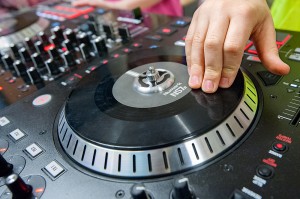Before classes begin at Smithland Elementary School in Harrisonburg each morning, beeps, beats and bass can be heard from Perry Shank’s music room. His students are learning the art of sound engineering with the help of music-mixing technology and scientific toys.
Shank [EMU BA ’99 in music] teaches his classes and the school’s DJ club how to make electronic music by layering sound.
Whether students use iPads, digital sequencers or the Numark mixdeck DJ system in the back of the classroom, they are taught to find the musical balance between “sound and silence.”
“If they’re in the car listening to music they can hear the themes we’ve dissected in class,” Shank said after the DJ club’s Monday morning session. “They start to understand how music works.”
All his students from kindergarten through fourth grade use the equipment. They learn how to “juggle” beats and scratch a record on the mixdeck.

The machine is a digital version of a vinyl turntable, with a computer screen to show the musical waves being created.
“It was tricky at first. It’s fun though,” said Leah Greenfield, 10. She and Liam Wightman, 10, will demonstrate the mixdeck for Harrisonburg City Public Schools’ STEM Day on Saturday [Feb. 28].
Across the room, third-grader Omari Faison, 9, tweaked the settings of a Korg digital sequencer to create a looped beat. The device contains 100 sound samples and fits inside a pencil case.
With a few adjustments, Omari was able to produce a range of beats.
Not all Shank’s technology is strictly designed for music.
Fourth-graders Anish Aradhey, 9, and Julia Obenschain 10, will use littleBits circuitry kits at STEM Day to build a synthesizer. Shank said the kits allow users to work on separate currents for greater collaboration.
Anish said the trick is to keep all the pieces connected so the sound stays intact.
“And to save power, you have to turn [the battery] off when you’re building it,” Julia said.
Shank received grants from James Madison University, Smithland’s parent-teacher organization and the division’s Transforming Classrooms Through Technology program. The division purchased the mixdeck last year using leftover music program funds, while Shank also brought some of the equipment from home.
“It’s great because the kids work on troubleshooting their own issues,” Shank added.
He wanted enough tools to let students work independently during class time.
“Technology’s kind of my thing,” he said.
To hear some of the students’ creations go to www.soundcloud.com/dj_maestro01 .
Courtesy of the Daily News-Record, Feb. 24, 2015
